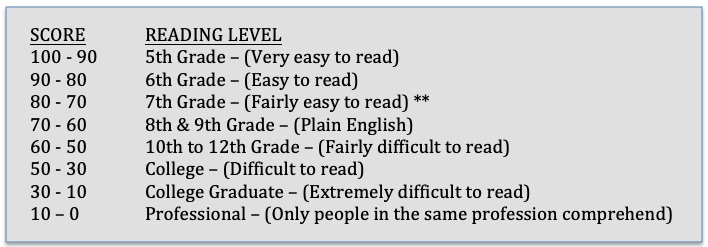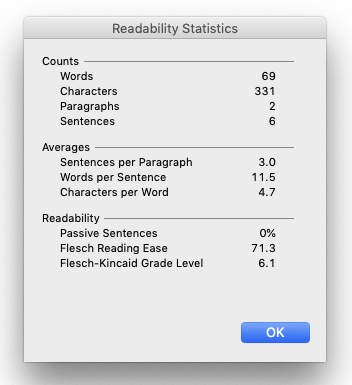
This summer, I have been learning “how to edit” my first thriller novel (Commercial Fiction) with the help of a professional editor. So far, it has been an enlightening experience. I had no idea there were so many different levels and layers to the editing process. If I did, I might have quit writing years ago. *Joking! I love the torture.*
Last week, I tackled the “Passive Voice” found within my novel. I am currently sitting between 2-3% Passive Voice. A score of less than 5% in your manuscript is acceptable. While educating myself on how to remove it, I stumbled upon something else. Before I tell you, I want to ask a question:
Do you know why some novels only sell a handful of copies and other novels sell millions?
Truth: I have no idea.
However, I have discovered a small writing secret that might help you: Write your novel using Readability Statistics.
What is Readability?
Readability refers to how easy and enjoyable your words are for readers to understand in plain and simple language.
What happens when you select complicated words chosen from a Thesaurus, instead of simpler words? Readers lose focus and stop reading. You do not need to dumb down your words, just use normal simple language that you would use in everyday conversation.
Everyone’s readability will be different. If you only write what’s readable for you, there might be some confusion or frustration around your content. Therefore, check the readability score.
How do you check for readability?
There are multiple online readability tests, but Microsoft Word has the most popular method, the Flesch-Kincaid Readability Score already built-in. You can change your settings and preferences to view it at any time while you are writing your manuscript. To set this option, go here:
For PC users: Go to Word > Options > Proofing > Click “Show Readability Statistics” Box.
Mac users: Go to Word > Preferences > Spelling and Grammar > Click “Show Readability Statistics” Box.
Note: You will need to run the Spelling and Grammar in your document first. Once complete, the Readability Statistics Box will pop up with all your information.
Flesch-Kincaid Reading Score Formula:
206.835 – 1.015* (total words/total sentences) – 84.6* (total syllables/total words)
After calculating your score, check out the following table to match it with a corresponding reading level:

These statistics are based on the Flesch-Kincaid mathematical formula to predict the difficulty of adult reading material. This test indicates the higher your score, the more reader-friendly your manuscript is. The lower your score, the more difficult it is to read. Occasionally, you will have a manuscript over the 100% mark, like a Dr. Seuss book (116%) meaning it is extremely easy to read.

A GOOD readability score to aim for is above 70%. A GREAT score leaning toward a best seller is above 80%. If you can improve your readability score, your book will be more reader-friendly. Of course, this is only a quick calculation to determine how your audience will comprehend your writing. You will need to make sure the words make sense, encouraging them to keep turning the pages.
Everyone knows that the best writing will have your eyes racing across the page at lightning speed, flipping pages faster than a sneeze. If your eyes can move that fast without stumbling over bigger and more complicated words, it means the reader is easily grasping the material.
There have been many studies done on best selling authors who have successfully hit the Best Seller List.
Here are some examples of Readability Scores:
- Karin Slaughter – The Silent Wife – (Mystery/Thriller) – 80.0%
- Delia Owens – Where the Crawdads Sing (Historical Fiction) – 83.4%
- Stephen King – The Outsider (Horror/Suspense) – 80.0%
- Suzanne Collins – The Hunger Games (YA/Science-Fiction) – 83.0%
- Margaret Atwood – The Handmaid’s Tale (Can Lit/Speculative Fiction) – 96.0%
- F. Scott Fitzgerald – The Great Gatsby (Literary Fiction/Classic) – 95.0%
In Canada, the average adult reads between a Grade 6 to Grade 8 Level. About 58 of 100 Canadian adults aged 16 to 65 have the basic reading skills they need for most everyday tasks. The other 42 adults—9 million—have low literacy skills. If you include all the people over 65, that number rises to 12 million Canadians struggling with literacy.
In America, 50% of the average adult population is considered to have a readability level equivalent to a Grade 7 or 8 Level. One out of every six adults lacks basic reading skills. This means 36 million people can’t read a job application, understand basic written instructions, or read the Internet.
Most people prefer to read two grades lower than they are capable of.
Advice for writers of Commercial Fiction: Stop trying to impress all your family and friends with how many five-syllable words you have in your novel. Stop writing long descriptive passages of flowery prose. Remember who your audience is. Best selling authors have already figured this out for you, so why not take advantage of their advice?
When it comes to language, simple is better for success.
Of course, what the heck do I know? I am still working on the edits for my first novel.
Thanks Lori… going to check this out for my novel!
Excellent piece, Lori. As an adult educator I have used the Flesch Kincaid many times, especially for adults with lower reading capability. I have thought about using it for editing my novels and now that you’ve brought it up… it makes great sense. Thanks for this well-written, well- researched, piece.
Thanks Jeanette! I had no idea it was a tool you could use right in Microsoft Word. What a wonderful way to check on your writing. It is great for blog posts and short stories too! As I mentioned, I’m quite obsessed with reviewing my work to make sure my language hits the 70% mark before I publish, which is difficult when you are explaining technical things like mathematical formulas. Ha! Thanks again for reading the post. I truly appreciate the support. Hugs!
Wonderful article, Lori. Nice it’s in Microsoft. I didn’t know that either but I use Autocrit.com. There is a fee, but I find some of these fees worth the price.
Hi Rose-Ann! Thanks for reading the blog post. It sounds like you love using Autocrit.com. I haven’t heard of this software/service, but I’ll be sure to investigate it. Thanks for the heads-up. Happy writing and editing. Hugs!